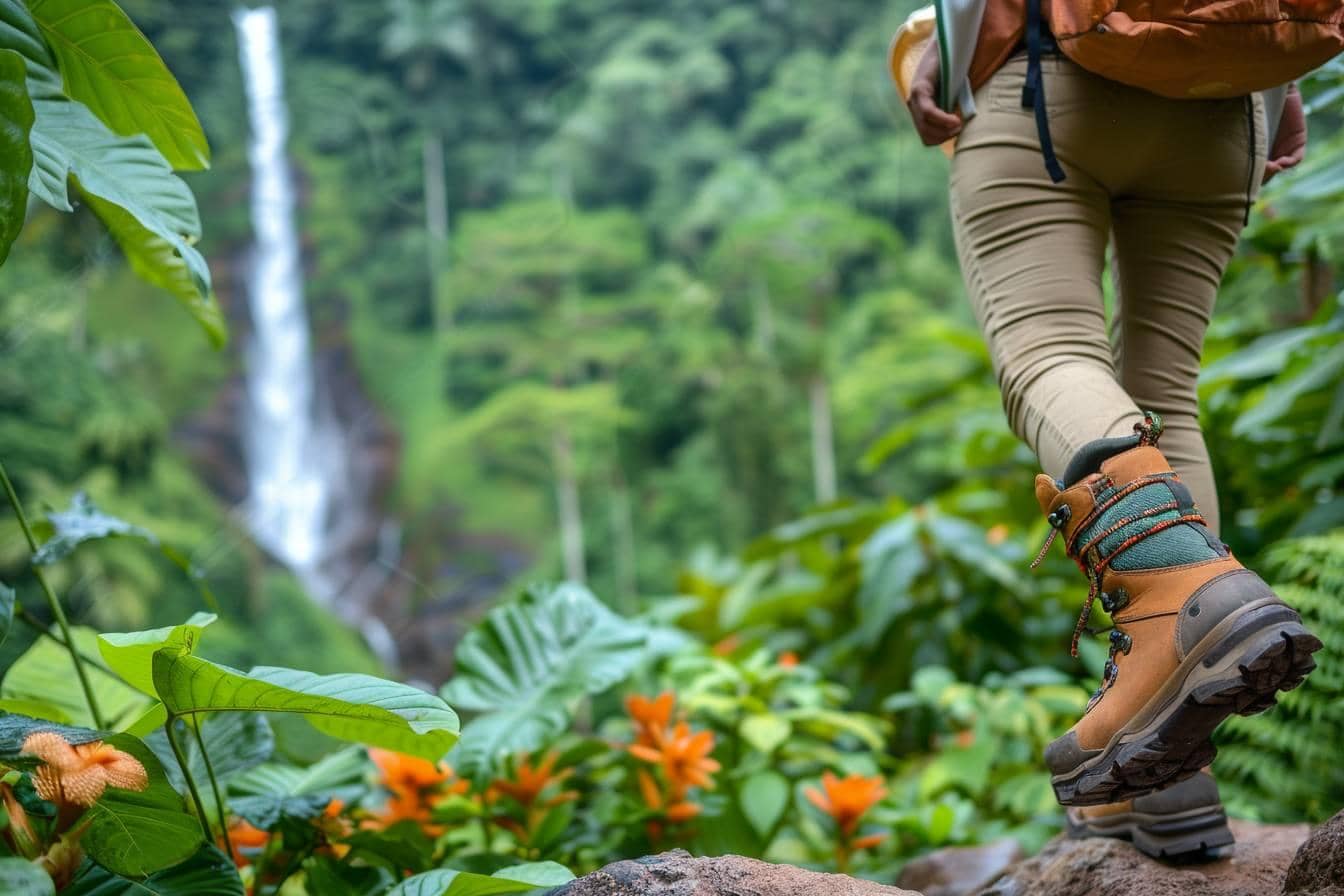Exploring Hawaii’s rugged landscapes through hiking is an exhilarating adventure that plunges you into the heart of its natural beauty. However, the islands’ diverse terrains and climates present unique challenges requiring thorough preparation.
In my years of trotting around the globe, tackling trails from Southeast Asia’s dense forests to the Andes’ steep paths, I’ve garnered a wealth of hiking safety knowledge.
Drawing on these experiences, I aim to guide you through essential safety tips for hiking in Hawaii, focusing on crucial aspects like proper footwear, hydration, and navigation. Each tip is a stepping stone towards ensuring your Hawaiian hiking experience is as safe as it is breathtaking.
In this article
- Choosing the right gear for the trails
- Hydration and nutrition on the trail
- Mastering navigation: maps and compasses
- Navigating Hawaii's unique challenges
Choosing the right gear for the trails
When hiking in Hawaii, the right gear is your first defense against the unpredictable elements and terrains you’ll encounter. Starting with footwear, investing in sturdy, well-fitting hiking boots is non-negotiable.
Trekking across lava fields or slippery mud paths, I’ve learned that a solid grip can make or break your hike. Your boots should offer ample support and traction to safely navigate Hawaii’s varied landscapes.
Next, consider your apparel. Lightweight, breathable clothing is essential to manage the heat but always carry a waterproof jacket. On one of my treks through the Waipio Valley, I was caught in a sudden downpour, and my waterproof jacket was a lifesaver. This unpredictable weather is typical in Hawaii, underscoring the importance of always being prepared.
Remember accessories like a brimmed hat and UV sunglasses to protect against the sun’s intensity, especially at higher elevations where UV exposure increases. A quality backpack designed for hiking will comfortably carry your essentials, including water, snacks, and first aid supplies.
Hydration and nutrition on the trail
Hydration is pivotal on any hike, especially in Hawaii’s humid and warm climate. I adhere to the guideline of consuming half to one quart of water per hour of hiking, ensuring I balance this with electrolyte replenishment.
This approach helps prevent dehydration and hyponatremia—a condition caused by low sodium levels in the blood. Bringing along sports drinks or electrolyte mix can make all the difference in maintaining your energy levels and hydration balance.
Equally, nourishment provides the fuel your body needs to traverse these demanding landscapes. My go-to is high-energy, portable snacks like nuts, energy bars, and dried fruit. They’re lightweight and pack a powerful calorie punch to sustain my energy.
During one of my memorable hikes along the Napali Coast, I found that regular snack breaks significantly improved my endurance and overall enjoyment of the trek.
In addition to carrying sufficient water and snacks, knowing where to refill your water bottles and planning your meals around your hike can significantly improve your hydration and energy levels.

Mastering navigation: maps and compasses
Despite the well-marked trails in some of Hawaii’s hiking areas, there are still many remote paths where signage is sparse or non-existent. I always carry a detailed map and a compass on these hikes.
Learning to navigate using these tools has been invaluable, especially when my tech gadgets have failed. A map won’t run out of battery, and a compass doesn’t need a signal. Together, they’re infallible companions that have guided me back to civilization more than once.
It’s not just about having these tools but knowing how to use them. I took a short course on navigation before venturing into remote regions, which I’d highly recommend. Understanding topography and orienting your map to your surroundings have enhanced my hiking experiences, enabling me to explore off the beaten path confidently.
A strong advocate for preparedness, I also suggest checking trail conditions and weather forecasts before setting out. Hawaiian weather can be highly variable, impacting trail conditions and your safety. You can get more information here.
This proactive step can prevent being caught in dangerous situations, such as flash floods in valleys or sudden fog on ridges that severely reduce visibility.
Navigating Hawaii’s unique challenges
Hawaii’s trails offer an array of unique challenges, from volcanic terrains to dense rainforests. One aspect that surprised me during my initial hikes was the swift change in weather conditions.
One moment, you’re basking in sunshine; the next, you’re drenched in rain. This experience taught me the importance of diligently checking weather forecasts and constantly preparing for changes. A lightweight poncho or rain jacket has become a staple in my pack.
Another challenge is Hawaii’s volcanic terrain, particularly on trails around active areas like those on the Big Island. Trekking these areas requires caution and respect for the natural environment.
MORE IN HAWAII?
- Hawaii Adventure: Kids, Beaches & Culture
- Embrace Aloha Spirit: Discover Hawaii
- Hawaii on a Budget: Paradise for Pennies
- Hawaii Volcano Safety: Hike Smarter
- Unveiling the Best Time to Visit Hawaii
- Rainbow Falls State Park Hawaii: Map Directions and Reviews
- What are the Activities To Do Walking Punaluu Black Sand Beach
Stay on marked trails to avoid hazardous zones where the ground can be unstable or toxic gases might be present. During a hike near Kilauea, I witnessed the mighty power of nature—a humbling experience that underscored the need to adhere to safety guidelines.
The diversity of Hawaii’s landscapes also means you could be hiking at sea level one day and at high elevations the next. Acclimatizing to elevation changes is something to consider, as altitude can affect your physical performance and overall health. Taking it slow, staying hydrated, and listening to your body are vital practices I follow to adjust.
In summary, Hawaii provides an unparalleled hiking experience, blending stunning scenery with the thrill of adventure. Yet, it demands respect for nature’s forces and a commitment to safety.
With the right gear, proper hydration and nutrition, and skillful navigation, your Hawaiian hiking adventure can be both exhilarating and safe. Embrace these practices, and you’ll enjoy the landscapes and return home with rewarding memories of your time on the trails.




